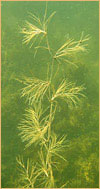|
|
 |
 |
|
|
 |
 |
 |
|
Member of the Wildlife & Environment
Society of South Africa Western Cape Region
|
 |
|
|
|
| Eco Bites |
 |
| Potamogeton in
Rietvlei |
 |
|
A problem for recreational
users of Rietvlei and the
members of the Milnerton
Aquactic Club is the
excessive growth of Potamogeton
pectinatus, the water grass also
known as sago pondweed, or
fennel-leaved pondweed. It has
always been present in Rietvlei,
but the last few years have seen
a bloom in growth around the
edges of North and South Lake. |
|
There are about 20 Potamogeton
species internationally, most of which occur
only in the northern hemisphere;
Potamogeton pectinatus is the
only one found throughout the
world. It grows in wetlands,
lakes, rivers, canals, ditches
and ponds from sea level up to
nearly 5 000m above sea level;
it is also the only Potamogeton
species found in brackish water.
It has been recorded growing in
waters 6-7m deep, but it is
dependent on light penetration
and in turbid waters will rarely
grow deeper than 2-3m. |
 |
|
Potamogeton stands are important
feeding and rearing habitats for
waterfowl, fish and many other
organisms. It is not only a
source of food, but also
provides a protected habitat for
many aquatic animals. In many
parts of the world migratory
waterfowl have established their
migration pathways via water
bodies dominated by Potamogeton
spp. In Rietvlei and many other
wetlands in South Africa it is a
major source of food for coot
(bleshoender) and several other
waterfowl species, as well as
many fish species - they not
only eat the plant itself, but
also feed on the large
populations of microfauna living on
Potamogeton stems and
leaves. |
|
Another positive function of Potamogeton
is that it protects
shorelines from wave erosion.
The plants form wide stands
close to shore and is a very
effective buffer against waves.
This can be seen quite clearly
in Rietvlei when the southeaster
is blowing strongly; the
Potamogeton stands along the
northern shores of North Lake
very effectively dampen the
waves and minimise erosion. |
|
However, there is also a
downside to Potamogeton. Because
it grows so prolifically, it can
clog irrigation canals and is a
nuisance to recreational users –
it interferes with fishing lines
and winds around powerboat
propellers. It is also
unpleasant and can even be dangerous
for swimmers to venture into Potamogeton stands
as they can get tangled up in
the plants and
get into difficulties. |
 |
|
Control of Potamogeton |
|
Numerous research projects into control
methods have been carried out
throughout the world, including
the use of herbicides and other
chemicals. These herbicides range from
aromatic solvents, copper
sulphate solutions, diquat,
paraquat, 2,4-D butoxethanol
ester pellets, and numerous
others. While many affected
the growth of Potamogeton
temporarily, none stopped
sprouting and the plants were
not exterminated. Many also have
deleterious effects on aquatic
life and are not recommended for
use in open waters. (Please note
that the use of aquatic
herbicides requires approval
from various authorities). |
|
Mechanical methods of removal
have also been tried; these
include using large rakes,
cables, and mechanical
harvesters. While such methods
are successful in clearing
artificial canal systems and in
opening channels through Potamogeton stands,
they are not permanent and must
be repeated at regular intervals
to keep growth at bay. |
|
Biological control methods have
been studied in various parts of
the world; a burrowing
chrysomelid beetle causes great
damage to Potamogeton, but has
not permanently eradicated the
plant in study areas. Grass carp
was introduced into the United
States to control Potamogeton
and other nuisance aquatic
plants, but it has exterminated
virtually all aquatic plants in
water bodies to which it had
been introduced and caused a
complete collapse of the
ecosystem – leading to the
disappearance of other fish and
bird life in such systems. Today
the transportation of grass carp
world-wide is strictly
controlled, South Africa has
strict legislation in place to
prevent importation of grass
carp (several years ago grass
carp were imported by several fish
farmers, but these populations
are under strict surveillance to
prevent escape into natural
systems). |
|
The problem recreational users
have with Potamogeton in
Rietvlei will not be easily
solved. People using
Rietvlei will have to accept
that the plant is here to stay
and that they must live with it. The
only remedy is to clear channels
in the Potamogeton stands to
allow boats access to the shore,
it can also be cleared in areas
where anglers require access to
the water. However such clearing
will have to be repeated at
regular intervals to ensure that
these
channels stay open. |
 |
|
Compiled by Niel van Wyk from
various sources. |
|
 |
|
|
 |
|
|